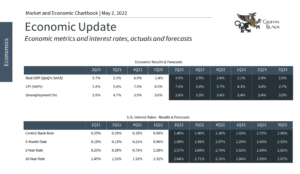For some investors it may feel as if the market can’t catch a break. After what has already been a difficult start to the year, last week’s GDP report confirmed that economic growth slowed for the first time since the pandemic began. This news, along with higher interest rates and faster Fed tightening, has driven the S&P 500 back into correction territory and the Nasdaq into a bear market. What should long-term investors focus on during this challenging period?
The negative news is easy to see and is being amplified by many information outlets. The latest GDP report for the first three months of the year showed that the country’s gross domestic product shrank by 1.4% on an annualized, quarter-over-quarter basis. This simply means that there was less spending in some parts of the economy last quarter. And while this was a negative surprise, even the 1% growth rate that economists had expected would have been a deceleration. At this point, the drags on the economy are mostly old news: high inflation and energy prices, Fed rate hikes, the war In Ukraine, etc.
Yet there is also positive news beneath the surface that could matter more in the months, quarters, and years ahead. Consumer spending actually grew 2.7% even after adjusting for inflation. Also, while economic growth slowed compared to the previous quarter, it still rose 4.3% when compared to the prior year. It was mostly a decline in government spending, a worsening trade deficit and changes to business inventories that made overall GDP negative last quarter – and these are factors that could rebound too.
That said, the negative headline number has naturally raised concerns over a possible recession. Recessions are technically defined as two consecutive quarters of negative growth. But the organization that officially decides recession dates, the National Bureau of Economic Research, considers a variety of economic data in making a formal determination. Fortunately, many aspects of the economy still look robust, even if they are not perfect. The job market, in particular, is exceptionally strong, with unemployment of only 3.6% and wages for hourly workers rising 6.7%.
For long-term investors, what matters is not that the economy is perfect – it’s that overall growth will support corporate earnings and thus market returns. And most US companies are still doing well in spite of high inflation and other sources of uncertainty, with an S&P 500 earnings-per-share estimate of $237 a year from now. Over the course of full business cycles, it is profitability that propels stocks and portfolios ahead, allowing investors to achieve their financial goals.
Even if a recession were imminent, the reality is that they occur every five to ten years across history. The pandemic-driven recession, for how severe and destructive it was, only officially lasted two months. In other words, these are not unexpected events; they are a natural part of the full business cycle of expansion and contraction.
So rather than living in fear of the natural ebb and flow of the economy, investors ought to hold long-term portfolios that are designed to withstand these fluctuations and not try to adjust their portfolios on-the-fly. While pessimism can occasionally pay off in the short run, it almost never helps in the long run. Even when the situation fails to evolve as investors hope, portfolios that are properly positioned and diversified often find a way to perform well in spite of the negative headlines.
The more optimistic perspective for investors is that the economy can continue to grow at a steady pace once it adjusts to the obvious near-term challenges. Below are three charts that help to put the economic situation in perspective.
1.Economic growth slowed during the first three months of the year. The economy contracted slightly for the first time since the pandemic began. But this weakness was driven by government spending, business inventories, and the trade deficit. Consumer spending was robust during this period despite rising inflation.
2.Bull and bear markets behave very differently. Recessions and bear markets are natural parts of the economic and market cycle. Investors should hold portfolios that can withstand these periods rather than treat them as special cases. It is notable that bull markets tend to be long, lasting from several years to up-to-a-decade or more. Bear markets, on the other hand, tend to be much shorter.
3.Economists expect steady but moderate growth.  The negative GDP number for Q1 was driven by factors that are widely known. Economists expect steady but moderate growth in the coming quarters as the economy and world get back on track. This is the case despite inflationary concerns, Fed rate hikes, and more. Investors shouldn’t lose sight of these long run trends.
The negative GDP number for Q1 was driven by factors that are widely known. Economists expect steady but moderate growth in the coming quarters as the economy and world get back on track. This is the case despite inflationary concerns, Fed rate hikes, and more. Investors shouldn’t lose sight of these long run trends.
Image by Rawpixel.com from Shutterstock



